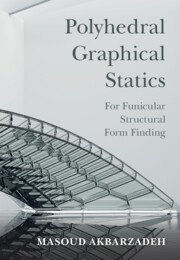Book contents
- Frontmatter
- Dedication
- Contents
- Contributors
- Foreword
- Foreword
- Preface
- Acknowledgments
- Introduction: A Brief History
- 1 Equilibrium of a Single Node
- 2 Equilibrium of a System of Forces
- 3 Compression-Only Form Finding
- 4 Articulated Compression-Only Forms
- 5 Systems with Combined Tension and Compression
- 6 Geometric Degrees of Freedom in Design of Form and Force Diagrams
- 7 Algebraic Formulation for Polyhedral Graphic Statics
- 8 Broader Applications of Polyhedral Graphic Statics
- References
- Index
3 - Compression-Only Form Finding
Published online by Cambridge University Press: 13 March 2025
- Frontmatter
- Dedication
- Contents
- Contributors
- Foreword
- Foreword
- Preface
- Acknowledgments
- Introduction: A Brief History
- 1 Equilibrium of a Single Node
- 2 Equilibrium of a System of Forces
- 3 Compression-Only Form Finding
- 4 Articulated Compression-Only Forms
- 5 Systems with Combined Tension and Compression
- 6 Geometric Degrees of Freedom in Design of Form and Force Diagrams
- 7 Algebraic Formulation for Polyhedral Graphic Statics
- 8 Broader Applications of Polyhedral Graphic Statics
- References
- Index
Summary
This chapter introduces compression-only form finding in both 2D and 3D. The properties of primitive constrained funicular forms in 2D and 3D are explained. The step-by-step procedures for constrained form finding for a single applied load in 2D and 3D are provided. The form-finding process is then extended from a single applied load to a non-concurrent system of loads, for instance, a series of parallel applied loads. We show how the form and force diagrams can be combined using the Minkowski sum to check the correctness of funicular construction. The relationship between the applied loads and the number of non-concurrent loads in polyhedral systems is explained. A design technique by subdividing the applied loads is introduced that yields a variety of load networks and, thus, shells with various topologies. Besides, the effect of support locations in 3D is illustrated using multiple examples. We provide examples to show an approach to controlling the width of funicular forms in 3D and constraining a funicular form’s height. The topic of the three-hinged arch in 2D and 3D is introduced, and the construction of overlaying funicular geometries for asymmetric loading scenarios is then explained.
Keywords
- Type
- Chapter
- Information
- Polyhedral Graphical StaticsFor Funicular Structural Form Finding, pp. 99 - 174Publisher: Cambridge University PressPrint publication year: 2025

